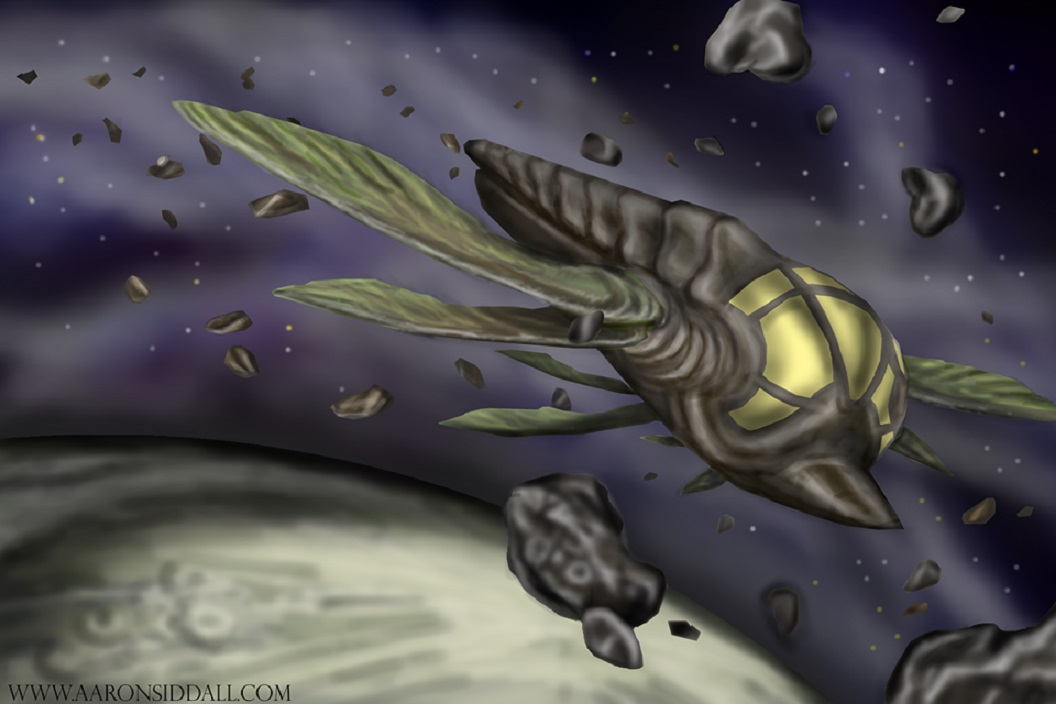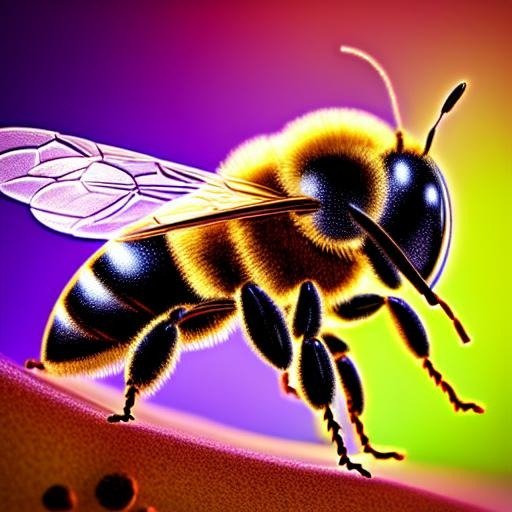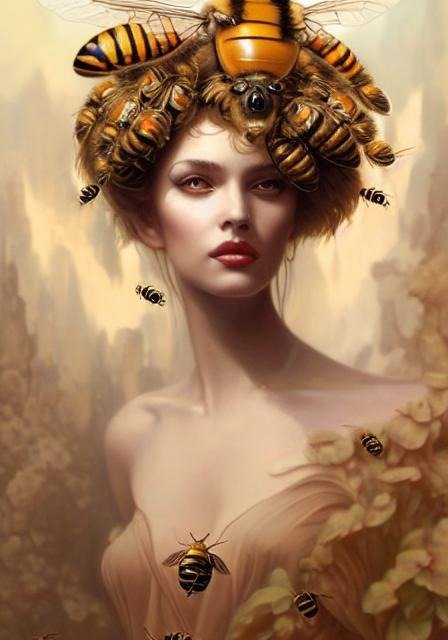Celestial Bee
Ooh! Oh! Um... Those are... very large bees.
What, them? Oh, no need to worry. Those are celestial bees. They're very peaceful and quite clever beings! You have to work to make them angry. If they sting you, you almost certainly deserved it.Celestial bees are a species of bee that grows to enormous proportions. Queens are the size of large dogs, and the worker members of the hive range from about the size of the palm of one's hand to roughly a foot in length, depending on their age. They appear to be unique to Trees of Life and possibly Ironwood Trees. Fortunately, these large honeybees are patient and good-natured, rarely taking exception to anything other than a direct assault on the hive. They also seem to be incredibly bright. Some naturalists insist they are, in fact, sapient.
Basic Information
Anatomy
Celestial bees resemble giant honeybees, with some traits unique to the species. They are insectoid, with clearly-visible yellow and black stripes along the length of their abdomens. The front of their bodies is black and "bunchy," but covered in soft, yellow hairs that enthusiasts report are pleasant to the touch.
Bees differ from wasps and hornets by having branched or plume-like hairs (called setae,) combs on the forelimbs for cleaning their antennae, small differences in limb structure, and veined rear wings. In females, the seventh dorsal abdominal plate is divided into two half-plates.
Bees have the following characteristics, which are also typical of celestial bees:
A pair of large compound eyes which cover much of the surface of the head. Celestial bees have even larger compound eyes than normal, covering most of the head's surface.
The antennae usually have 13 segments in males and 12 in females, and have an elbow joint part of the way along. They contain large numbers of sense organs.
Celestial bees, in addition to these antennae, have similar sensory receptors on the ends of a pair of extra "manipulator-limbs" that extend from their thorax. These limbs are typically used to grasp objects, assist with accessing nectar, and serve many of the functions of hands and fingers.
Mouthparts are adapted for both chewing and sucking by having both a pair of mandibles and a long proboscis for sucking up nectar.
The thorax has three segments, each with a pair of sturdy legs, and a pair of membranous wings on the hind two segments. These wings have an iridescent, almost crystalline appearance. The wings are synchronised in flight, and the somewhat smaller hind wings connect to the forewings by a row of hooks along their margin which links to a groove in the forewing.
The front legs of celestial bees have combs for cleaning the antennae, and the hind legs have pollen baskets, flattened sections with incurving hairs to secure collected pollen.
The abdomen has nine segments. The hind three have been modified into a venomous stinger. The peaceful demeanor of the bees continues even in their venom; one bee's dose of venom is a neurotoxin that induces sleep and a strong hangover effect. It takes at least three bees' doses of venom to kill a human-sized victim, and the victim simply passes out and fails to wake up as their heart stops, with little evidence of pain.
Genetics and Reproduction
Female celestial bees develop from fertilized eggs and males from unfertilized eggs. Because a male is haploid (has only one copy of each gene), his daughters (which are diploid, with two copies of each gene) share 100% of his genes and 50% of their mother's. Therefore, they share 75% of their genes with each other.
As a result, celestial bee females are more closely related to their sisters than they would be to their own offspring. Workers often do not reproduce, but they pass on more of their genes by helping to raise their sisters (as queens) than they would by having their own offspring (each of which would only have 50% of their genes.)
Drones (male celestial bees) search for queens after emerging from their adult pupation, and seek queens to mate with. After mating, a female stores the sperm, and determines which sex is required at the time each individual egg is laid, fertilizing eggs to produce female offspring, or choosing not to in order to produce male offspring.
Celestial bee workers, unlike in many other bee species, can choose to mate and become queens themselves, and this may be done when a hive population is threatened.
Growth Rate & Stages
The life cycle of a celestial bee begins with the laying of an egg, the development through several moults of a legless larva, a pupation stage during which the bee undergoes complete metamorphosis, followed by the emergence of a winged adult.
The eggs are oblong, slightly curved and tapering at one end. Like celestial bee wings, they have a crystalline appearance, though it is unknown if they actually possess a crystalline structure. Celestial bees feed the larva regularly while it grows.
Larvae are whitish-iridescent grubs, roughly oval and bluntly-pointed at both ends. They have 15 segments and spiracles in each segment for breathing. They have no legs but move within the cell. They have short horns on the head, jaws for chewing food and an appendage on either side of the mouth tipped with a bristle.
There is a gland under the mouth that secretes a viscous liquid which solidifies into the silk they use to produce a cocoon. The cocoon is semi-transparent and the pupa can be seen through it.
Over the course of a few days, the larva undergoes metamorphosis into a winged adult. When ready to emerge, the adult splits its skin dorsally and breaks out of the cell.
Ecology and Habitats
Being giant honeybees, celestial bees build enormous wax hives, varying from the size of castles to the size of small towns. These hives contain literal tonnes of honey.
Dietary Needs and Habits
The large size of celestial bees is likely due to its adaptation to living in Trees of Life. The symbiotic flowers that often grow on its bark are enormous; and therefore, the bees that pollinate them and live on their nectar must be as well.
Biological Cycle
Some naturalists claim that celestial bees are capable of hibernating for centuries at a time. This is believed to be a response to the mercurial environment of the wilds of space. If a Tree of Life that is inhabited by a celestial bee colony reaches a place in its orbit where sunlight is limited and flowers do not bloom, the colony enters a hibernation state that lasts until sunlight returns and the flowers bloom again.
Behaviour
Celestial bees exhibit an unusual level of patience, and seem to display a sophisticated understanding of the intentions of sapient beings. Some prominent naturalists, such as Xune Celestis and Alesander Tremayne, have posited this is indicative of their own sentience. However, others claim this might simply display a keen sense of smell that can detect subtle shifts in pheromones, indicating potential hostility. The counterargument points out that these bees do not seem to react to displays of fear, unless that fear is also accompanied by direct violence. The scholarly debate continues.
Additional Information
Uses, Products & Exploitation
While celestial bees will attack anyone who attacks their hives, some druids and naturalists have managed to develop a relationship with friendly hives, and have coaxed them into sharing their honey, royal jelly, and other byproducts, in return for assistance and protection. This is perhaps the greatest sign of their possible sapience, since they can rarely be outsmarted in this. Xune Celestis is famous throughout the stars for her unusual blend of celestial honey and Star Mushroom spore mead.
Perception and Sensory Capabilities
Celestial bees have compound eyes, which are visual organs consisting of thousands of tiny independent photoreception units (called ommatidia). Each ommatidia is made up of an individual cornea, lens, and photoreceptor cells which distinguish brightness and colour. The image perceived by a compound eye is a combination of inputs from the ommatidia, which are oriented to point in slightly different directions. Compared with single-aperture eyes, compound eyes have poor image resolution; however, they have a very large view angle and the ability to detect fast movement and the polarization of light. As a result, celestial bees respond in 0.01s compared with 0.05s for humans.
Between and above the compound eyes are three small simple eyes (called ocelli) which provide information on light intensity.
The antennae and "manipulator-limbs" of a celestial bee have sense organs that can detect touch, smell and taste; and small, hairlike mechanoreceptors that can detect air movement, enabling a bee to "hear" sounds.
Like other honeybees, celestial bees also communicate the location of sources of nectar through a "wiggle dance." Unlike other honeybees, they can navigate over several sound-minutes successfully to find nectar in their environment.
Don't forget that you can click on the blue compass on the left to access the Table of Contents at any time!

Want to read all of the Toy Soldier Saga fiction, even before the rest of the world does?Subscribe now!
Scientific Name
Apis mellifica caelestia
Lifespan
Unknown. Some naturalists claim that celestial bees can live for up to a hundred years or more.
Conservation Status
Celestial bees only exist where Trees of Life are found. As a result, they are extremely rare, but widely distributed throughout Known Space.
Geographic Distribution
Xune Celestis by Rachealmarie







I love bees. <3 I love these bees too. I really enjoyed the section about celestial bees and gravity. :D I hope they are sapient, I love that idea.